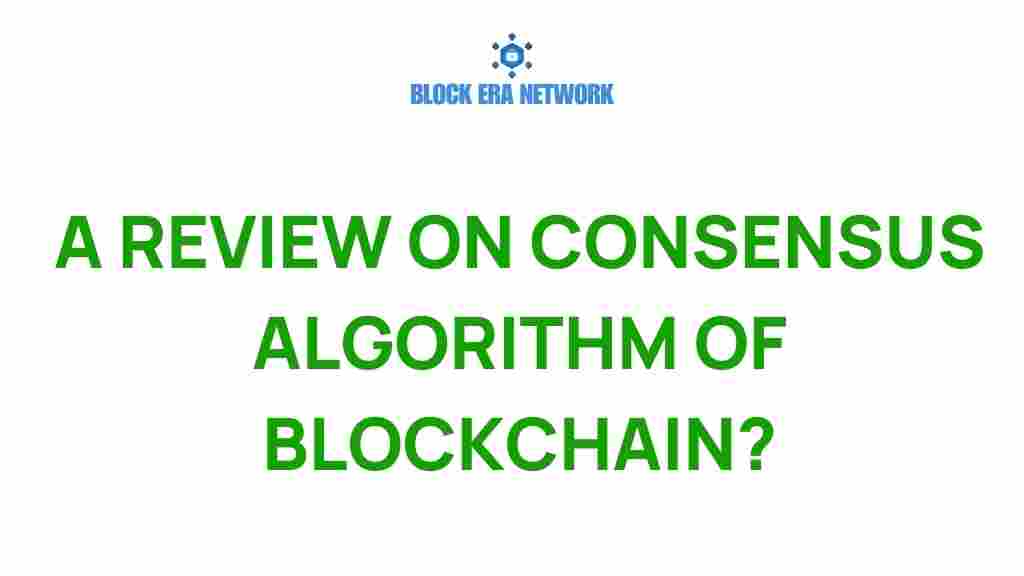Unraveling the Mysteries of Blockchain’s Consensus Algorithms
In the realm of blockchain technology, consensus algorithms stand at the core of its functionality, ensuring that all participants in a decentralized system agree on the state of the blockchain. These algorithms are vital for validating transactions and maintaining the integrity of the network. As we delve into the intricacies of these algorithms, we will uncover their significance in the validation processes, the impact on network security, and their role in addressing scalability challenges.
Understanding Consensus Algorithms
At its core, a consensus algorithm is a mechanism used in blockchain technology to achieve agreement on a single data value among distributed processes or systems. The need for consensus arises from the decentralized nature of blockchain, where no single entity controls the entire network.
Consensus algorithms are crucial for:
- Validation Processes: Ensuring that all transactions are legitimate and accurately recorded.
- Network Security: Protecting the network against malicious attacks and fraud.
- Scalability: Allowing the network to handle an increasing number of transactions.
Types of Consensus Algorithms
There are several types of consensus algorithms, each with its advantages and disadvantages. The two most common are:
- Proof of Work (PoW): Used by Bitcoin, PoW requires miners to solve complex mathematical problems to validate transactions and add new blocks to the blockchain.
- Proof of Stake (PoS): Used by networks like Ethereum 2.0, PoS allows validators to create new blocks based on the number of coins they hold and are willing to “stake” as collateral.
Proof of Work: A Deeper Dive
Proof of Work is the original consensus algorithm, introduced by Bitcoin in 2009. It serves as a validation process that ensures all transactions are secure and prevents double-spending. Here’s how it works:
- Miners compete to solve a cryptographic puzzle.
- The first miner to solve the puzzle gets to add the new block to the blockchain.
- As a reward, the miner receives a predetermined amount of cryptocurrency.
While PoW enhances network security, it has notable downsides, such as:
- High Energy Consumption: Mining requires significant computational power, leading to environmental concerns.
- Scalability Issues: The time taken to mine blocks can slow down transaction processing.
Proof of Stake: The Alternative Approach
Proof of Stake was designed to overcome the limitations of PoW. In this model, validators are chosen to create new blocks based on their stake in the network. Here’s how PoS works:
- Validators lock up a certain amount of cryptocurrency as collateral.
- They are then selected to validate transactions and create new blocks based on their stake and other factors.
- If a validator acts dishonestly, they risk losing their staked coins.
Advantages of PoS include:
- Energy Efficiency: Unlike PoW, PoS doesn’t require massive energy consumption, making it more environmentally friendly.
- Enhanced Scalability: PoS can process transactions more quickly, allowing for greater scalability.
Other Notable Consensus Algorithms
Besides PoW and PoS, several other consensus algorithms exist, each with unique features:
- Delegated Proof of Stake (DPoS): Participants vote for delegates who validate transactions on their behalf, improving efficiency.
- Practical Byzantine Fault Tolerance (PBFT): A consensus protocol designed for systems that require high transaction throughput and low latency.
- Proof of Authority (PoA): Validators are pre-approved, making it a centralized form of consensus suitable for private blockchains.
Scalability Challenges in Blockchain
As blockchain networks grow, they face significant scalability challenges. High transaction volumes can slow down validation processes, leading to increased fees and longer wait times. Consensus algorithms play a critical role in addressing these challenges:
- Improving throughput by processing multiple transactions simultaneously.
- Reducing block confirmation times to enhance user experience.
- Implementing sharding or layer-two solutions to distribute load and improve efficiency.
Troubleshooting Consensus Algorithm Issues
While consensus algorithms are designed to maintain network integrity, they can sometimes encounter issues. Here are some common problems and troubleshooting tips:
- Forks: When two miners solve a block simultaneously, a fork may occur. To resolve this, the network typically selects the longest chain as the valid one.
- Centralization Risks: In PoW systems, large mining pools can dominate the network. Encouraging smaller miners and implementing changes can mitigate this.
- Staking Problems: In PoS, validators may face issues if they do not have enough stake. Ensuring a diverse set of validators can improve security.
Future of Consensus Algorithms
The evolution of blockchain technology continues to shape the future of consensus algorithms. Innovations are underway to create more efficient, secure, and scalable solutions. Some trends to watch include:
- Hybrid Models: Combining different consensus mechanisms to optimize performance.
- Interoperability: Developing consensus protocols that allow different blockchains to communicate and share data.
- Environmental Considerations: As sustainability becomes a priority, eco-friendly consensus mechanisms will gain traction.
Conclusion
Consensus algorithms are the backbone of decentralized systems, ensuring secure and efficient transaction validation in blockchain technology. Understanding the intricacies of these algorithms, including proof of work and proof of stake, is essential for anyone looking to navigate the evolving landscape of blockchain. As we continue to explore new innovations in network security and scalability, the future of consensus algorithms promises to be exciting and transformative.
For more information on how blockchain works, visit this comprehensive guide. To learn more about specific consensus mechanisms, check out this external resource.
This article is in the category Blockchain Basics and created by Block Era Network Team

3 thoughts on “Unraveling the Mysteries of Blockchain’s Consensus Algorithms”